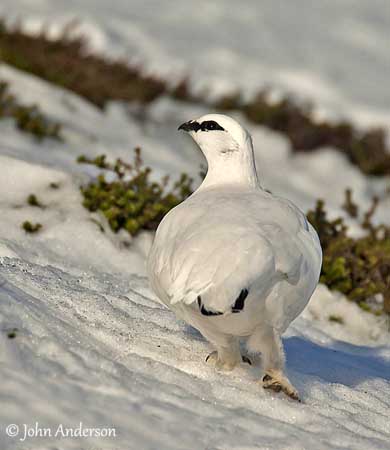
Fr: Lagopède alpin
All : Alpenschneehuhn
Esp : Lagópodo Alpino
Ital : Pernice bianca delle Alpi
Nd: Alpensneeuwhoen
Sd: Fjällripa
Photographers:
John Anderson
John Anderson Photo Galleries
Tom Merigan
Tom Merigan’s Photo Galleries
Ingo Waschkies
Bird Photography
Text by Nicole Bouglouan
Sources:
HANDBOOK OF THE BIRDS OF THE WORLD Vol 2 by Josep del Hoyo-Andrew Elliot-Jordi Sargatal - Lynx Edicions - ISBN: 8487334156
ENCYCLOPEDIE DES OISEAUX DE FRANCE ET D’EUROPE – de Peter Hayman et Rob Hume - Flammarion – ISBN : 2082009920
THE COMPLETE BOOK OF BRITISH BIRDS – Written by “Royal Society for the Protection of Birds” experts - Préface de Magnus Magnusson - Michael Cady- Rob Hume Editors - ISBN: 0749509112
THE HANDBOOK OF BIRD IDENTIFICATION FOR EUROPE AND THE WESTERN PALEARCTIC by Mark Beaman, Steve Madge - C.Helm - ISBN: 0713639601
BirdLife International (BirdLife International)
All About Birds (Cornell Lab of Ornithology)
Wikipedia, the free encyclopaedia
Rock Ptarmigan
Lagopus muta
Galliforme Order – Tetraonidae Family
BIOMETRICS:
Length: 33-38 cm
Weight: M: 470-740 g – F: 430-700 g
DESCRIPTION:
The Rock Ptarmigan is master of disguise with a plumage providing it a superb camouflage in all seasons. It moults three times.
During winter, the adult is entirely white except the black bill and the dark eyes.
The male shows black lores and rear of the eye, and bright red eye comb, fairly narrow in winter. Even legs and feet are feathered white. However, the outer rectrices are black, forming a triangular patch on each side of the tail, conspicuous in flight.
The female is similar but she lacks the red eye comb.

When the spring begins to melt the snow, both sexes develop mottled plumage to merge into the background. Some brown-grey spots appear on their white plumage.
During summer, the male has grey-brown plumage, appearing mostly grey on head, upperparts, throat, neck and breast. Chin and rest of underparts including the feathered legs and feet are white. The red eye combs are always present and are increasing in size.
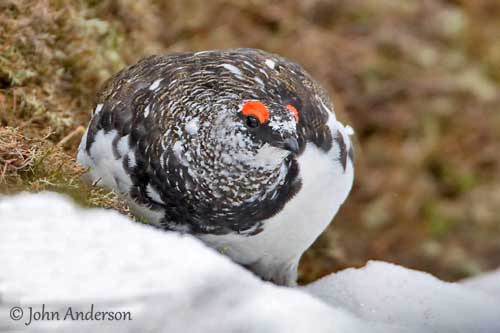
The female has pale buff plumage overall, with fairly large black spots on upperparts. The white belly shows black and buff spots and streaks along the lower flanks. She has narrow reddish eye combs.
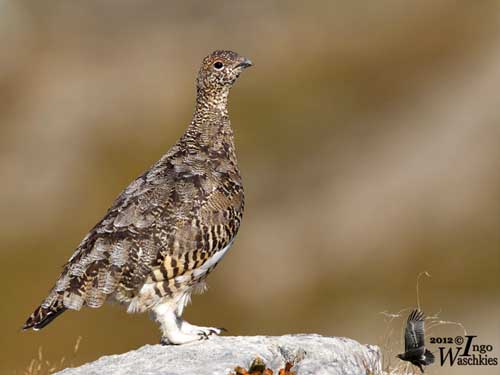
During autumn, both sexes become greyer on head and upperparts, while belly, vent and legs are white. The female’s upperparts are whiter than in summer plumage.
The male has reduced red eye combs.

In both sexes, the outer rectrices are black and the wings are white in all plumages. The male is usually mostly grey except in winter, whereas the female is buff with black mottling and spotting, but she is white during winter too.
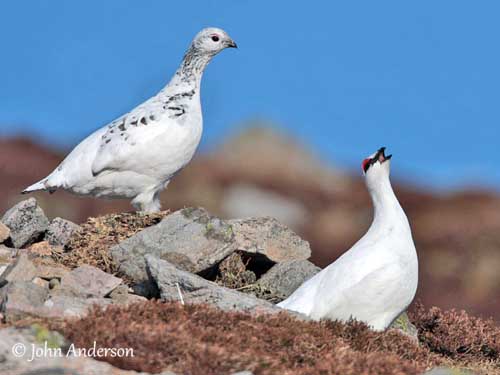
The juvenile resembles adult female, but it has greyish-brown upperwing and brown tail patches, not black.
The first winter resembles adults, but the outer pair of primaries often differs in amount of pigment.
In all plumages, the bill is black. The eyes are dark brown. Feathered legs and feet are white, serving as “avian snow shoes”!
We can find numerous subspecies sharing the wide range. They differ slightly in colour and pattern of summer plumage.
VOICE: SOUNDS BY XENO-CANTO
The Rock Ptarmigan male utters a distinctive flight call, a dry, low-pitched cackle “ARR-arr-kakarr” also used during displays or when flushed.
It often gives a prolonged grating such as “ARR-arr-kakarrrrrr k k k k k k k k”. A low “kuk” is produced by both sexes.
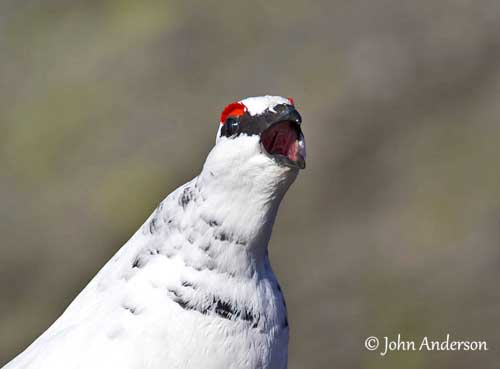
HABITAT:
The Rock Ptarmigan frequents rocky country in tundra with sparse vegetation, and further south, it is found in mountains.
This species is rarely seen in high shrubs or below the tree-line. In Scotland, it is common in boulders and outcrops, and in stunted heather mixed with herbaceous vegetation.
It is usually found above 2000 metres in S mountains (Alps and Pyrenees), and above 5000 metres in Pamir Alaï in C Asia. In Iceland, it is found at sea-level.
During winter, it may move to less snowy areas in order to find some ground vegetation to feed.
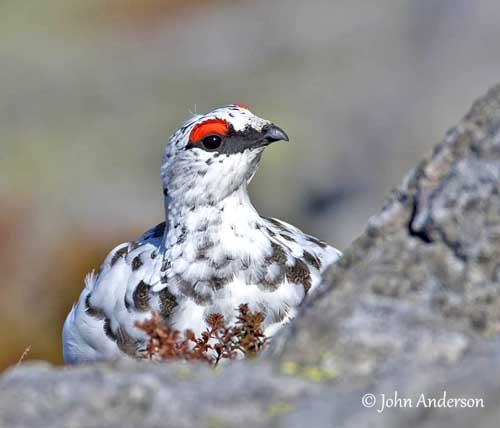
RANGE:
The Rock Ptarmigan breeds across arctic and subarctic Eurasia and N America, and Greenland. This species is common in the Arctic Cordillera, and there are several isolated populations in mountains of Scotland, the Pyrenees, the Alps, Bulgaria, Urals, Pamir Mountains, Altay Mountains and Japan.
It can be found in all countries circling the North Pole, including Greenland, Iceland, Europe, Asia and N America, and in mountainous areas of S Europe.
BEHAVIOUR:
The Rock Ptarmigan in winter takes food from the ground. This food depends on localities and snow conditions. Food items can be buds and catkins of birch (Betula), or buds and twigs of willow (Salix). It also takes berries from shrubs in the Alps and other southern regions.
From spring to autumn, the diet includes leaves, flowers, berries and seeds of several plant species.
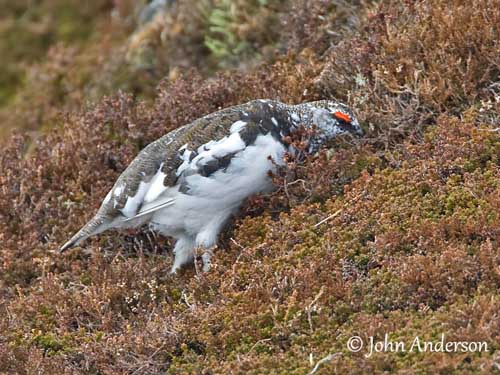
Outside the breeding season, they can be seen in flocks in late autumn and winter for better protection. These flocks gather several dozens of birds, but males and females live in separated groups.
The males often occupy the front line, as well against predators as in harsh weathers, feeding in exposed places. The Golden Eagle is the main predator of this species in mountains, finding them even in all white plumage on the snow.
Unlike several Tetraonidae species, the Rock Ptarmigan is monogamous (like the two other members of genus Lagopus). The male is paired with a single female and guards her until the end of the incubation period.
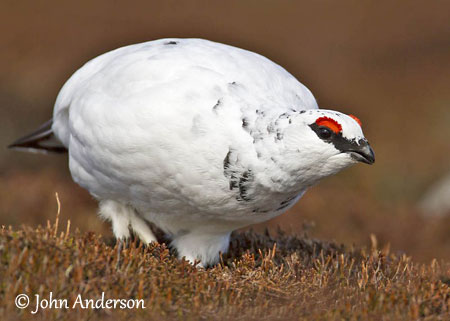
The male is strongly territorial and guards the territory through the winter until spring when the females arrive. This area can be crucial before the laying, because the food resources are still limited after the winter. For this reason, competition between males is essential. Females usually prefer to mate with male associated to good territory.
The male performs advertising displays, using both visual and vocal signals, and violent attacks may occur. It performs an advertising flight during which it takes off vertically until ten metres or more off the ground. Then, it glides with wide open wings and tail while giving a rhythmical call carrying up to a kilometre away “err-ouk-kakakaka-koua-koua-koua”. Finally, it drops down again, uttering noisy cackles accelerating little by little. It ends up with a display posture, exposing the triangular black tail patches.
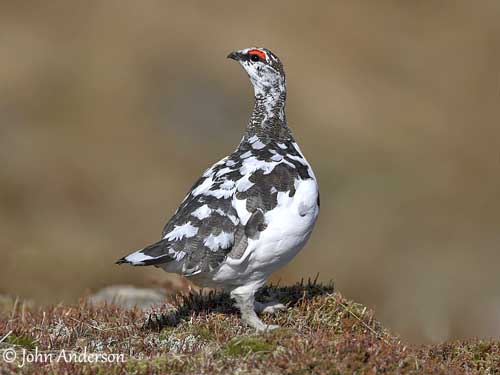
Song and display activity by males usually take place at dawn in order to avoid the attention of predators. They often select safe places to display.
During courtship, the male drags one wing on the ground and the tail is fanned to enhance the black patches. It raises the red eye combs and circles the female.
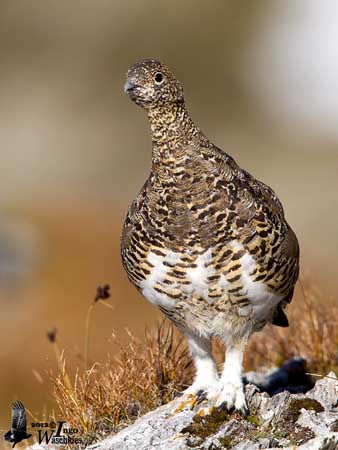
According to the range, this species is preyed upon by the Golden Eagle, the Glaucous Gull, the Arctic Skua and the Arctic Fox.
The Rock Ptarmigan’s populations make limited movements, mainly altitudinal and related to local weather conditions and food resources.
Arctic populations perform greater movements but mainly nomadic. The North American females have been reported to migrate farther south before to return to the breeding areas.
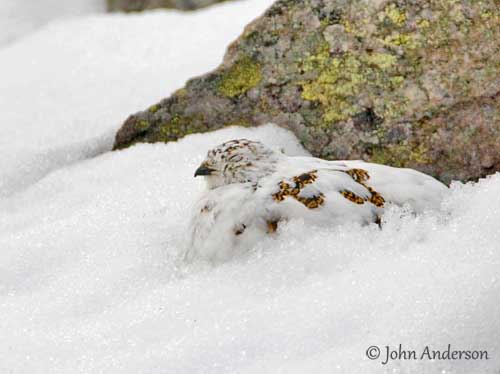
FLIGHT:
The Rock Ptarmigan flies fast on stiff wings. It performs frequent wing-beats interspersed with glides. The flight is brief but strong. When flushed, it bursts into full, rapid flight.
REPRODUCTION:
The laying occurs in June.
The Rock Ptarmigan’s nest is a shallow depression on the ground, usually in open but placed in sheltered location, close to shrub or large stone. The nest is lined with plant materials such as grass, twigs and leaves, and some feathers can be added too.
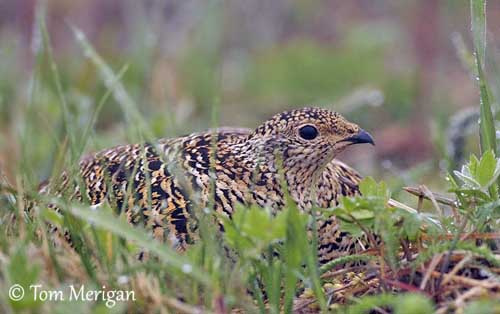

The female lays 5-8 creamy-buff eggs, heavily spotted dark brown. She incubates during 21-24 days. She is protected by her highly cryptic plumage.
At hatching, the chicks have brown crown bordered with black lines, and brownish down with grey patches. They are able to fly ten days after hatching. They feed on insects and plant materials and walk around the tundra one day after hatching. They are independent three months later and can breed at one year old.
This species produces a single brood per year.

DIET:
The Rock Ptarmigan feeds mainly on plant matter such as buds, twigs, leaves, flowers, berries and others. The chicks feed also on insects in addition to vegetal items.
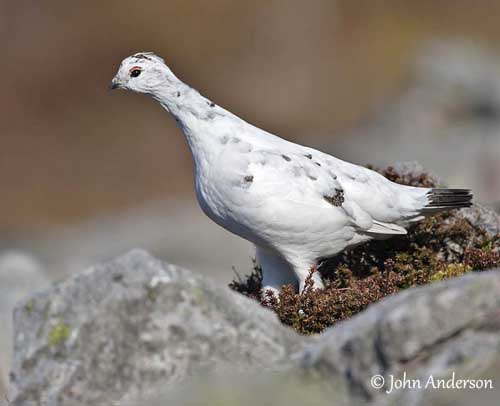
PROTECTION / THREATS / STATUS:
The Rock Ptarmigan has wide range and population size is extremely large. This species lives in remote habitats, making them relatively secure.
Hunting may affect some isolated populations, but habitat loss and increasing disturbance due to mountain tourism and activities might be negative factors. Densities change greatly according to the range.
However, this species is not currently threatened.
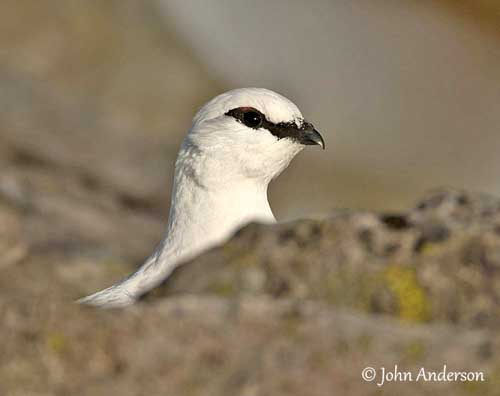
Male winter
Race Millaisi
Scotland
Pair winter
Race Millaisi
Scotland
Male spring
Race Millaisi
Scotland
Male winter
Race Millaisi
Scotland
Male late winter
Race Millaisi
Scotland
Male spring
Race Millaisi
Scotland
Male spring
Race Millaisi
Scotland
Female spring
Race Millaisi
Scotland
Female summer with chicks
Race Millaisi
Scotland
Male spring
Race Millaisi
Scotland
Female late winter
Race Millaisi
Scotland
Male winter
Race Millaisi
Scotland
Female summer
Race Helvetica
Switzerland
Male autumn
Race Helvetica
Switzerland
Male winter
Race Millaisi
Scotland
Female summer
Race Helvetica
Switzerland
Female summer
Race Nelsoni
Unalaska - Aleutian Is